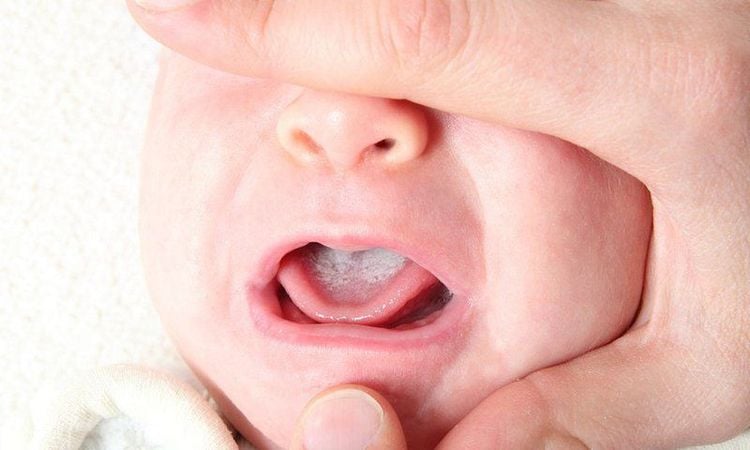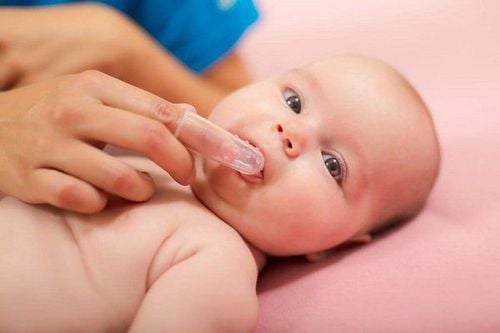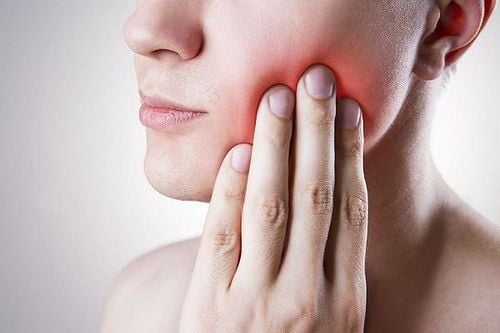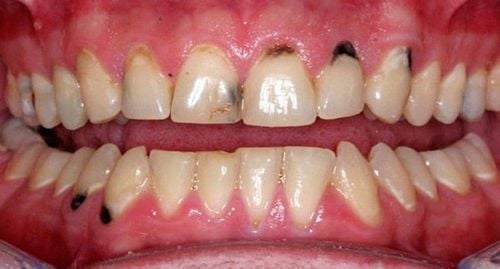White patches in the mouth are a sign of thrush in babies. The disease often occurs due to an excessive amount of yeast, mainly in the mouth and throat.
1. What is the condition causing white patches in a child’s mouth?
White patches in the mouth are a symptom of oral thrush. Oral thrush results in creamy or yellowish white patches developing on the sides of the mouth, palate, gums, lips, and tongue of the child. It can also spread to the throat, tonsils, or esophagus. Oral thrush is most common in infants and toddlers.
2. Causes of oral thrush in infants
Oral thrush occurs when there's an imbalance of yeast in the body. Antibiotics are one of the causes of oral thrush in young children, as they not only kill harmful bacteria but also a large number of "good" bacteria that control yeast levels in the body.
Sometimes, mothers and infants can pass the infection back and forth. An infant may transfer the thrush to the mother during breastfeeding, and vice versa. However, in some cases, neither the mother nor the child infects the other, even when one of them has the condition.
Oral thrush can also occur if a baby uses a bottle or pacifier for extended periods without proper hygiene. However, even exclusively breastfed babies who don't use pacifiers can develop oral thrush, making it challenging to pinpoint the exact cause. Some infants and mothers are simply more susceptible to yeast infections than others.

3. Symptoms of oral thrush
If you notice a white coating on your child's tongue, it may just be milk residue. Check by gently wiping the tongue. If it's not milk residue, visit a healthcare provider if you observe any of the following symptoms:
White or yellow patches on the lips, tongue, roof of the mouth, inside the cheeks, gums, or throat. These patches resemble small pieces of cheese and are difficult to wipe off.
Crying during feeding or when using a pacifier or bottle. This occurs because the white or yellow patches can be painful and make feeding uncomfortable if the infection is severe. Note: Some children with oral thrush do not feel pain or discomfort while breastfeeding.
Some children with oral thrush also develop a yeast diaper rash. This rash is raised, widespread, or bright red with clear borders. Small red spots may be tender or painful and often appear around the rash. It can also spread into the skin folds around the genitals and legs, though it rarely appears on the buttocks.
4. How to treat oral thrush?
If an infant is diagnosed with oral thrush, the commonly prescribed medication is an oral antifungal (usually nystatin) and pain reliever acetaminophen. The infection typically clears up after about two weeks of treatment.
For cases where the baby has a yeast diaper rash, nystatin ointment can be applied to the diaper area.
If you are breastfeeding a baby with oral thrush, applying nystatin or clotrimazole to the nipples can help prevent the infection from passing back and forth between mother and child.
It's important to follow up with a doctor if the infection doesn't clear up after treatment. Recurrent oral thrush is relatively common in children.

5. How to prevent oral thrush in infants?
Here are some measures to help reduce the risk of oral thrush in young children. These practices can also be beneficial for both the mother and baby being treated for thrush:
- Avoid giving your child antibiotics unless absolutely necessary, as antibiotics do not combat viral infections.
- In fact, oral thrush often occurs after taking antibiotics.
- Clean and sterilize pacifiers after each use, and disinfect any toys that go into the baby's mouth.
- Keep nipples dry between feedings
- If bottle-feeding, thoroughly clean all equipment, including nipples, after each use by washing with hot, soapy water or using a dishwasher.
- Wash hands frequently, especially after feeding the baby and changing diapers.
- Change the baby's diapers regularly to prevent yeast-related diaper rash.
6. Is oral thrush dangerous?
Oral thrush is not dangerous for young children. However, it can cause discomfort and pain during feeding, leading to fussiness and reduced breastfeeding efficiency.
Families should take steps to ensure the child is comfortable and follow the doctor's prescribed treatment instructions.

7. How to treat oral thrush at home? Can gentian violet be used to treat oral thrush in children?
Gentian violet should only be used under the guidance of a doctor. It is an effective antifungal medication, but prolonged use or using it at too high a concentration can cause mouth sores in children.
To prepare gentian violet at home:
- Purchase a 1% gentian violet solution. It can be found in many pharmacies or ordered from a pharmacy.
- To prevent side effects like mouth sores, dilute the solution to create a concentration of 0.25% or less by mixing one part gentian violet solution with two parts water.
- Before applying gentian violet, remove your child's clothes from the waist up to avoid staining them.
- Place a towel underneath to protect the surface below.
Steps to apply gentian violet:
- First, apply a thin layer of petroleum jelly to your child's lips and cheeks to prevent staining.
- Use a cotton swab to apply the diluted solution inside the child's mouth. Have someone help hold the child's head and hands while you swab the inside of the lips, cheeks, and tongue.
- Apply the medication once a day for no more than seven days.
- The dye is safe and does not harm nipples during breastfeeding.
Although oral thrush is not highly dangerous to a child's health, if left untreated or not treated promptly, it can lead to more severe conditions. Parents should consult a doctor to ensure optimal treatment for their child's oral thrush.
Please dial HOTLINE for more information or register for an appointment HERE. Download MyVinmec app to make appointments faster and to manage your bookings easily.
Reference source: babycenter.com
To arrange an appointment, please call HOTLINE or make your reservation directly HERE. You may also download the MyVinmec app to schedule appointments faster and manage your reservations more conveniently.








